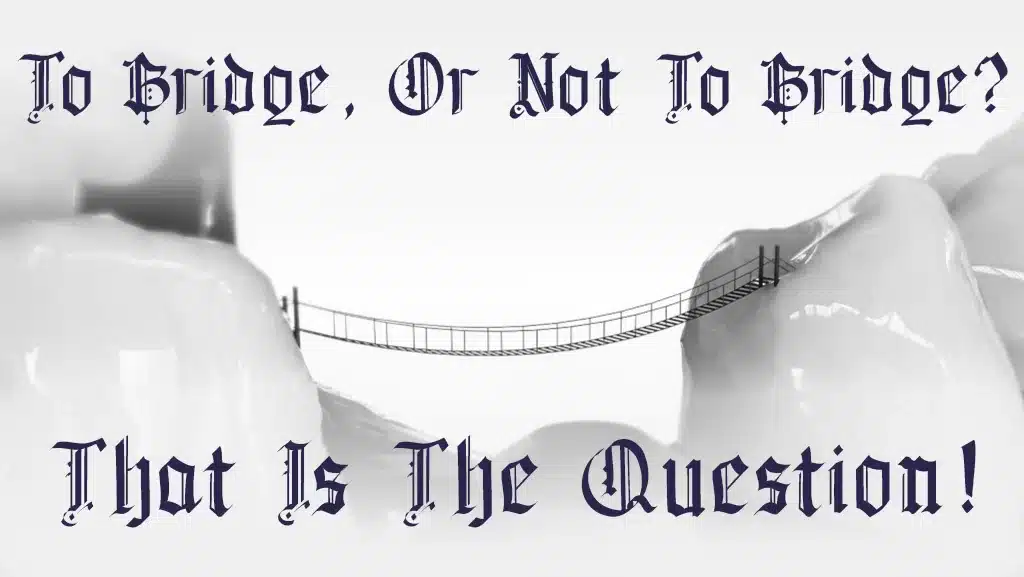As a dentist, I’m often asked about the best option for replacing a missing tooth.
The popular dental restoration options I’d like to cover in this blog post are dental bridges and dental implants. So really, the question is, “To Bridge, Or To Implant.”
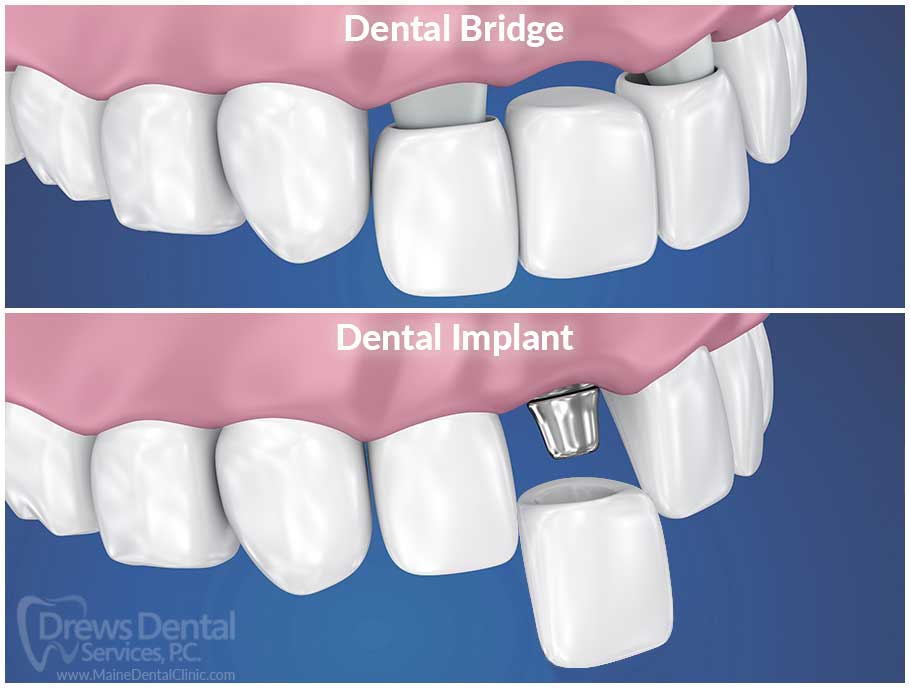
Bridges and implants are both types of dental restorations. Restorative dentistry is the part of my job that repairs or replaces natural teeth that may have been cracked, decayed or lost entirely. Both a bridge and an implant offer a solution to a missing tooth, but that’s just about where the similarities end. They get the job done, but in very different ways.
How A Dental Bridge Works
A dental bridge basically works to replace a missing a tooth by creating crowns for the two adjacent teeth with an artificial tooth (referred to as a ‘pontic’) that bridges the gap like this:
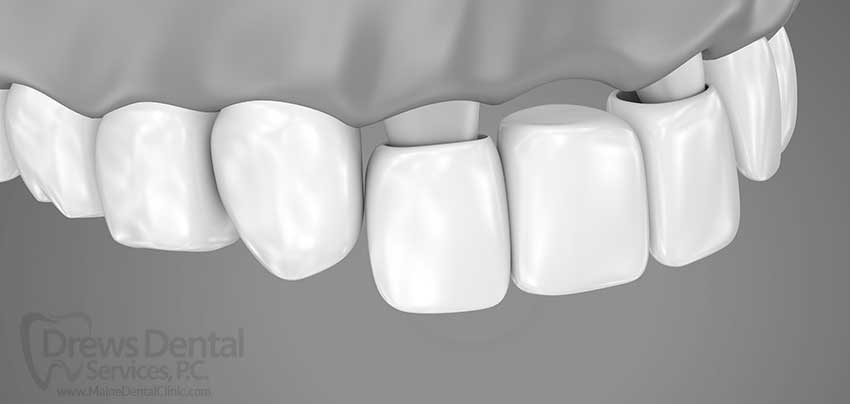
For our purposes here today, when I talk about a bridge I’m talking about a traditional bridge – the kind you’re most likely familiar with. You can learn more about the various types of bridges and what the procedure involves here.
How An Implant Works
Though an implant also works to replace a missing tooth, it does the job in a different way. Instead of relying on the adjacent teeth, it involves introducing a titanium post into bone, providing a stable root over which a crown can be placed, like this:
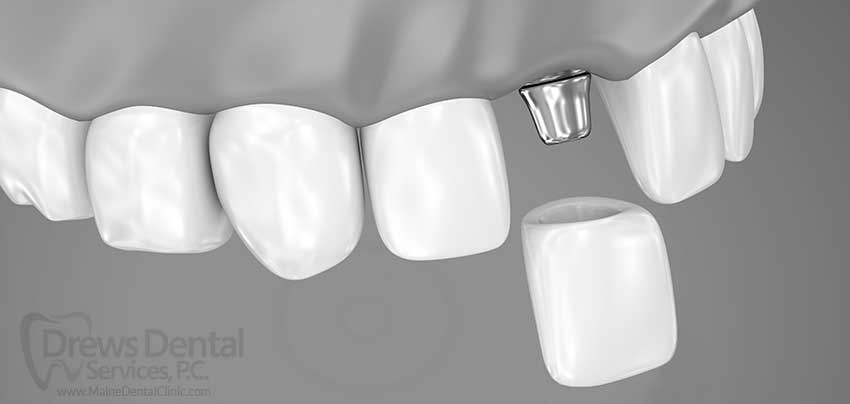
You can learn more about implants and what the procedure involves here.
In a simple comparison, dental implants are considered the most durable, functional, and natural solution for replacing missing teeth. While a bridge will affect adjacent teeth, dental implants do not and with improved technology the affordability of implants is better than ever. However; as is usually the case, there is no single best “simple” choice for all patients! Like nearly everything else in life, there are pros and cons to each of these solutions and the trick is finding the best option for YOU while taking as much into consideration as possible.
When I explain or try to compare dental concepts with my patients, I frequently find it useful to employ analogies that are easily understood in everyday life. For dental bridges and implants, I often use the construction of a house as a comparison. So try not to be surprised that I’m talking about fill dirt, foundations and neighborhoods as I talk about bridges versus implants.
Comparing & Contrasting
When we’re dealing with a missing tooth and whether to consider a bridge or an implant, we first want to take into account the current conditions and surrounding teeth. In other words, before we build our house, we first need to look at the land we’re putting our structure on.
Does the land have a slope right were we want to put our building?
Will we have to bring in a lot of fill dirt to provide support for our building?
Is the adjacent land at a higher elevation which will cause a collection of debris from runoff water? What does the neighborhood look like; are the adjacent houses nice or falling apart?
Does the land have a slope? Will we need a lot of fill dirt?
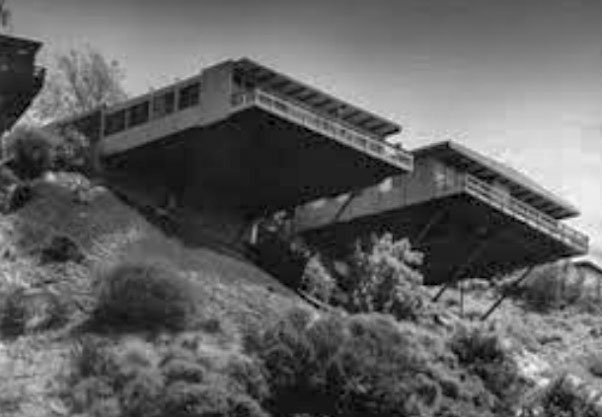
Look at figure 1. This house is literally built on the edge of a cliff.
For the house to be parallel with the horizon, the builder had to use stilts due to the lack of land to support the structure.
Dental Implant Option
For a dental implant to be a good choice, you must have enough bone to support the structure of the implant. It’s necessary for the dental implant to be covered in bone. If you don’t have enough of a foundation (bone), it does not mean you cannot get a dental implant, it just means the implant option will require an additional procedure called a ridge augmentation (fig. 2).
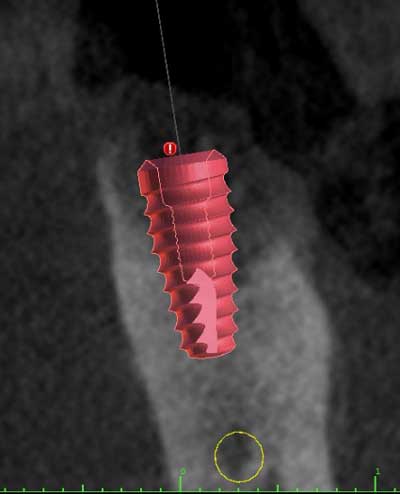
When building a house, this would be equivalent to having to bring in some fill dirt. A ridge augmentation is where the width of the bone is expanded by using bone collected from the you, the patient, or from a donor. The bone graft procedure also requires an additional 5 to 6 months to heal; but, once healed, there will be enough bone present to support the dental implant.
This additional procedure will add approximately $1,000 to the cost of the dental implant. That doesn’t mean that the implant cannot be done, it only means you would need to have realistic expectations of the timeline and cost for completion of the treatment option.
Dental Bridge Option
Now for the same situation, let’s look at a bridge. Missing bone for the bridge initially will not be an issue because the replaced tooth depends on the adjacent teeth for its strength. Unfortunately as the years go on, however, you might experience additional bone loss in the area under the missing tooth (fig. 3).
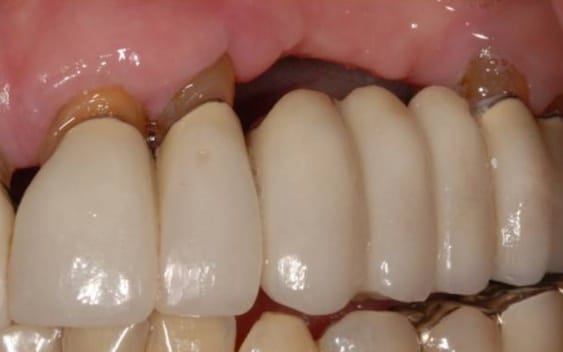
This will cause a possible esthetic concern or a location for food impaction which can weaken the adjacent teeth by causing dental caries. When this occurs, the whole bridge will need to be replaced, which is an additional cost added to the original solution cost.
So, the bone graft initially increases the cost of the implant tooth replacement; but, in the long run, a bridge replacement could end up making it the more expensive overall option.
Also, reports show a dental implant will help prevent bone deterioration because of the stimulation to the supporting bone.
Is the adjacent land at a higher elevation?
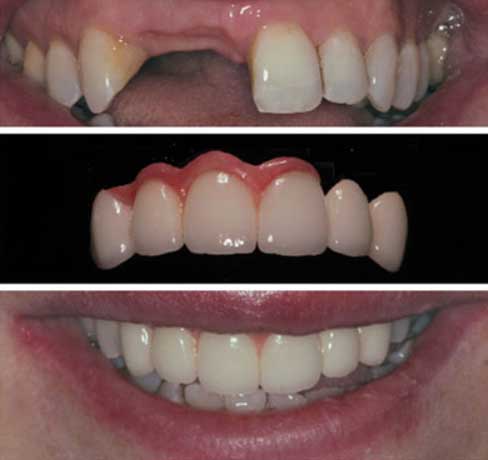
The next question evaluates the adjacent bone position to the missing tooth. Sometimes when a tooth is extracted a patient loses the bone that once supported that lost tooth, it creates what we call in dentistry a vertical bone loss.
Vertical bone loss is very difficult to deal with in dentistry. The bone grafting techniques for vertical bone defects are very complicated and the cost for these procedures is much higher then the ridge augmentation I talked about earlier. In fact, the extensive bone grafting could cost an additional $3000 to $5000 for an implant.
In these situations, if the patient is not willing to go through the extensive bone grafting, I would recommend a bridge or dental implants using pink porcelain to mask the vertical defect.
What do the other homes in the neighborhood look like?
Do you want to have the most expensive house in the neighborhood located in between two shacks? In dentistry, we need to look at the adjacent teeth, the teeth surrounding the missing tooth. Are the teeth in pretty good shape or are they falling apart and likely to require future restorations?
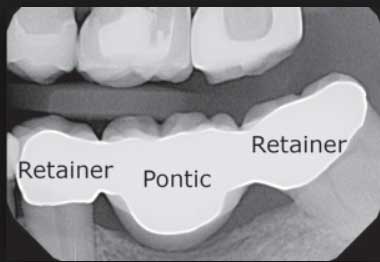
We always want to consider cost of treatment and if you have teeth that aren’t in great shape adjacent to the missing tooth, sometimes a good old-fashioned dental bridge is the better option since those teeth would get repaired as part of the treatment for replacing the missing tooth for function.
I still tend to advise patients that the best option, even in that situation, is a dental implant along with restorative repairs to the adjacent teeth – but if that’s not financially feasible, a dental bridge is an awesome alternative.
The opposite is also true. If the adjacent teeth are without any need of large restorations, it would be a shame to put grind them down to put crowns on perfectly good teeth for a bridge versus putting in a single dental implant to restore missing tooth.
Which Option Will Last Longer?
With the improvement of technology, the cost to do a single implant is approximately the same as doing a 3-unit bridge.
Dr. Peter Drews (on dental implant vs bridge)
Patients often ask which option will last longer and that’s a really, really good question since the cost of any procedure must also take into consideration whether it would need to be replaced (and how often that might be likely to happen).
This is actually a really difficult question to answer because there are so many factors. With traditional dental bridges, where we use the adjacent teeth to support the missing tooth, 5 year reports show a survival of approximately 89%. Depending on oral hygiene habits and other factors, a bridge might last 5 to 7 years or even a bit longer.
Since the adjacent teeth which have been crowned for a bridge are at risk for dental caries, we need to look at the individual patient and how they historically take care of their teeth. It is also very important when you have more complex dental restorations, like a dental bridge, that you come into the dental office for preventive care on a regular basis.
Reports show that implant supported crowns (implants that replace a single tooth) have a slightly higher survivability of approximately 96%.
It is very difficult to determine which option is best for the situation because there are many factors that contribute to the decision for each individual patient . . . which is why it’s important for you to consult with your Dentist or Prosthodontist to get the best solution for your individual needs.
That said, if you go into your consultation with a basic general knowledge and some factors to consider, you’ll be better equipped to understand your options.
Quick Comparison Chart
| BRIDGE VS. IMPLANT | FIXED BRIDGE | SINGLE TOOTH IMPLANT |
|---|---|---|
| Appearance | looks and feels natural | looks and feels even more natural |
| Adjacent Teeth | requires work to adjacent teeth (which can be a pro if those teeth need restoration or a con if they are otherwise healthy teeth) | nothing is required of adjacent teeth |
| Durability/Stability | durable and stable; nearly restores function | even more durable and stable; restores function |
| Oral Hygiene Routine | usual brushing and flossing; special floss or a floss threader to clean beneath the bridge | usual brushing and flossing |
| Longevity/Lifespan | 5 to 10 years (with proper care) | 15 years to a lifetime (with proper care) |
| Bones/Gums | possible bone and/or gum loss beneath the bridge (where the tooth or teeth are missing) | helps prevent bone and gum loss by stimulating the surrounding bone |
| Procedure Timeframe | no surgery; 2 or 3 visits over a matter of weeks | surgery; several visits over a matter of months |
| Cost/Insurance | likely less expensive up-front; possible replacement costs over time; covered by most insurance plans | likely more expensive up-front (depending on specifics); not covered by as many insurance plans |
While the Internet can give you a lot of information all at once, having a dentist you can trust to help you navigate ALL of your possible restoration options is always the absolute best solution to missing teeth – or whatever other dental issues you may have.
Want to talk about bridges, implants or building houses with me in person?! I’d be happy to oblige,



